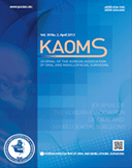Journal of the Korean Association of Oral and Maxillofacial Surgeons
- P-ISSN2234-7550
- E-ISSN2234-5930
- SCOPUS, KCI, ESCI
 ISSN : 2234-7550
ISSN : 2234-7550
Quantum of incisal compensation in skeletal class III malocclusion: a cross-sectional study
Kailasam Vignesh (Department of Orthodontics and Dentofacial Orthopedics, Sri Ramachandra Institute of Higher Education and Research (SRIHER), Chennai, India)
Ananthanarayanan Venkateswaran (Department of Orthodontics and Dentofacial Orthopedics, Sri Ramachandra Institute of Higher Education and Research (SRIHER), Chennai, India)
Abstract
Objectives: Skeletal class III malocclusion presents either with maxillary retrognathism, mandibular excess, or a combination. Dentoalveolar compensations occur with maxillary incisor proclination and mandibular incisor retroclination. The aim of this study is to quantify the amount of incisal compensation in class III skeletal malocclusion and correlate it to the severity of the skeletal base. Materials and Methods: Eleven angular and 7 linear cephalometric measurements were digitized from 57 patients. Axial inclination of the upper and lower incisors was evaluated for compensation. Pearson’s correlation coefficient was used to determine the dentoalveolar parameter among those measuring upper and lower incisor position and inclination that correlated most highly with the severity of class III. Linear regression analysis was used to identify the quantum of the incisal compensation. Results: Upper incisors were proclined and placed anteriorly. However, correlation analysis suggested a less responsive incisor with progressive change in skeletal base. Lower incisors began to compensate only as the severity of class III increased. For every degree of reduction of ANB angle from normal, the incisor mandibular plane angle (IMPA) and L1-GoMe decreased by 0.79° and the L1-GoGn decreased by 0.81°. Conclusion: The upper incisors contributed more to compensation compared to the lower incisors in a class III skeletal base. As class III severity increased, the upper incisor compensation decreased while that of lower incisors increased. For every degree of reduction in ANB angle, the IMPA and L1-GoMe decreased by 0.79° and the L1-GoGn decreased by 0.81°.
- keywords
- Malocclusion, Angle class III, Compensation, Regression analysis
- 다운로드 수
- 조회수
- 0KCI 피인용수
- 0WOS 피인용수